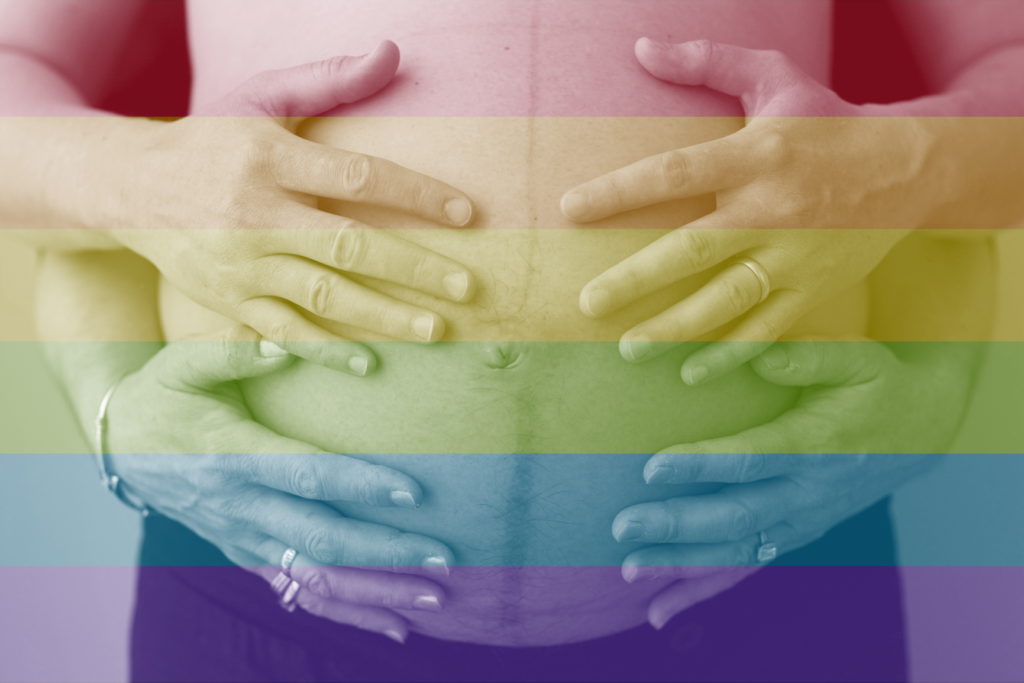As a gender-affirming psychologist, I am proud of the opportunity to amplify marginalized voices, especially those of queer couples, including transgender and non-binary folks in All the Love: Healing Your Heart and Finding Meaning after Pregnancy Loss.
Unfortunately, transgender pregnancy is highly misunderstood and often sensationalized with headlines such as, “Man gets pregnant!” “Man gives birth to a baby!” without having the basic understanding of vocabulary, biases, and barriers that can further impact this marginalized group.
I identify as a cisgender, heterosexual female. While I do not have the lived experience of a trans person, I have the privilege to work with members of the community and serve as an ally for nearly fifteen years.
Here are some common questions that I hear and that often people are too scared to ask:
1. What does it mean to be transgender or non-binary? What is gender identity?
Transgender (trans) is an umbrella term for people whose gender identity and/or expression is different from cultural expectations based on the sex they were assigned at birth. According to the Human Rights Campaign (HRC), gender identity is the “innermost concept of self as male, female, a blend of both or neither – is how individuals perceive themselves and what they call themselves. One’s gender identity can be the same or different from their sex assigned at birth.” A trans man is an individual whose gender identity is male but whose sex may have been designated female at birth. A non-binary individual does not identify with being either a man or woman. We understand that gender identity is best understood to be on a continuum or spectrum. In addition, a trans and non-binary person may choose or not choose to socially or medically transition. Not all trans folks want to start hormones replacement therapy (HRT) or engage in any gender confirmation procedures.
2. How is gender identity different from sexual orientation?
Sexual orientation is who you love, whereas gender identity is who you are—identifying as trans does not imply any specific sexual orientation. Therefore, trans people may identify as straight, gay, lesbian, bisexual, etc.
3. How can a transgender or non-binary person become pregnant?
Trans men are commonly born with reproductive anatomy (uterus and ovaries) to become pregnant and give birth. However, there are numerous barriers which may include stopping testosterone/hormone replacement therapy (HRT) which can re-trigger or worsen gender dysphoria. Gender dysphoria is the feelings of discomfort or distress in people whose gender identity differs from their ASAB. In addition, others barriers may include transphobia and lack of proper medical attention and care from medical and mental health providers.
Justin Brandt, an assistant clinical professor in the Department of Obstetrics, Gynecology and Reproductive Services at Rutgers Robert Wood Johnson Medical School, is a pioneer in the transgender pregnancy world. His study examined healthcare research on transgender men who became pregnant at or after age thirty-five to determine their medical and mental health needs. Dr. Brandt stated, “Despite the increased visibility of transgender people- there are about 1.4 million who have transitioned in the United States- medical providers are largely unprepared to care for them, and most have had limited educational opportunities.”
A significant portion of my work has been dedicated to educating other medical and mental health providers on how to provide gender affirming care to trans and non-binary folks, especially wtih pregnancy and pregnancy loss(es).
4. How does a pregnancy loss impact a trans person differently?
There are few studies about transgender folks, pregnancy, and then even pregnancy loss. In one of Australia’s most extensive studies, researchers interviewed twenty-five transgender men about their experiences with pregnancy. The overarching themes were loneliness and acknowledgment of the difficulty of becoming a parent in a world designed for cisgender folks.
Many of my clients report experiencing similar emotions following their pregnancy loss (sadness, shame, fear, anger, etc) but their situations were especially compounded due to the intersectionality of identities and systems of oppression that marginalized communities face.
5. How can I learn more about transgender pregnancies and folks?
There are several informative documentaries that highlight trans pregnancies. In the film, Seahorse, we can follow a trans male, Freddy McConnell, along his journey of conceiving and giving birth to a child. He credits the title of the documentary to the fact that male seahorses give birth to their babies.
Another excellent documentary is, A Womb of Their Own, which follows six diverse masculine-identified people who get pregnant and challenge the binary gender constructs in mainstream culture and even within the LGBTQ community. Viewers can share in the radical, joyful stories of establishing their unique gender and sexuality, growing a baby in their bodies, birthing, chest-feeding, and parenting their children.
**
According to Hazel Pickett, who shared his experience of pregnancy loss, “It is a bond of pain across all gender identities, connecting us in an understanding I wish we didn’t have. Through this process, I found a community of love and acceptance because it didn’t matter how I identified.”
Ultimately, the take-away message I reinforce in my practice and trainings is respecting individual differences and the diversity of lived experiences. Here are some other tips on being an ally from The Trevor Project, GLAAD, and the National Center for Transgender Equality.
This post was written by Huong Diep, co-author of All the Love: Healing Your Heart and Finding Meaning After Pregnancy Loss.





